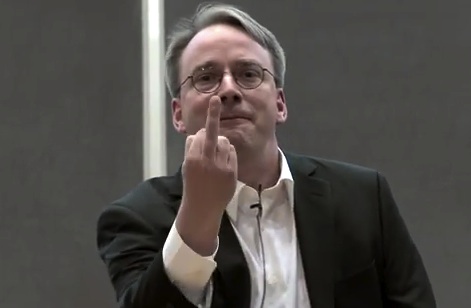Torvalds’ Finger Gets A Response From Nvidia PR, Nothing Else
Having recovered from Linus Torvalds’ epic bird-flipping over the weekend, NVIDIA’s PR department issued a statement containing no apology and no promises. Not that we were expecting any.
Torvalds’ description of Nvidia as “one of the worst trouble-spots [they’ve] had with hardware manufacturers” left us with very little hope of anything changing on the Nvidia front. And true to form, the statement presented us with nothing more than a list of everything Linux-related in Nvidia history.
Supporting Linux is important to NVIDIA, and we understand that there are people who are as passionate about Linux as an open source platform as we are passionate about delivering an awesome GPU experience.
Recently, there have been some questions raised about our lack of support for our Optimus notebook technology. When we launched our Optimus notebook technology, it was with support for Windows 7 only. The open source community rallied to work around this with support from the Bumblebee Open Source Project http://bumblebee-project.org/. And as a result, we’ve recently made Installer and readme changes in our R295 drivers that were designed to make interaction with Bumblebee easier.
While we understand that some people would prefer us to provide detailed documentation on all of our GPU internals, or be more active in Linux kernel community development discussions, we have made a decision to support Linux on our GPUs by leveraging NVIDIA common code, rather than the Linux common infrastructure. While this may not please everyone, it does allow us to provide the most consistent GPU experience to our customers, regardless of platform or operating system.
As a result:
1) Linux end users benefit from same-day support for new GPUs , OpenGL version and extension parity between NVIDIA Windows and NVIDIA Linux support, and OpenGL performance parity between NVIDIA Windows and NVIDIA Linux.
2) We support a wide variety of GPUs on Linux, including our latest GeForce, Quadro, and Tesla-class GPUs, for both desktop and notebook platforms. Our drivers for these platforms are updated regularly, with seven updates released so far this year for Linux alone. The latest Linux drivers can be downloaded from www.nvidia.com/object/unix.html.
3) We are a very active participant in the ARM Linux kernel. For the latest 3.4 ARM kernel – the next-gen kernel to be used on future Linux, Android, and Chrome distributions – NVIDIA ranks second in terms of total lines changed and fourth in terms of number of changesets for all employers or organizations.
At the end of the day, providing a consistent GPU experience across multiple platforms for all of our customers continues to be one of our key goals.
Nothing to see here, people. Moving on.
(via Phoronix)
Have a tip we should know? tips@themarysue.com
